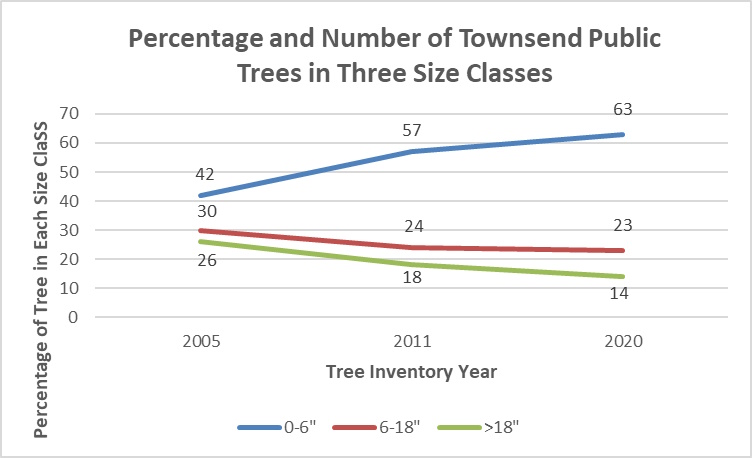Example Article for Tree Board
Townsend’s Community Forest Part 9
 | Author:
Patrick Plantenberg, Tree Board Chair
Townsend Tree Board Chair, Townsend Rotary Club |
Townsend’s Community Forest Part 9
Patrick Plantenberg
Tree Board Chair
Note: This is the ninth in a series of articles from the Townsend Tree Board reporting on the status of the community forest in Townsend.
Last week, we discussed the value of Townsend’s urban forest. The 1,093 trees inventoried in 2020 were valued at $2,164,000 even though over 52% of Townsend’s trees are less than 15 years old. This is an average price of $1,980 each. Trees did not grow in Townsend historically except where they received additional water. Without active watering, most trees in Townsend would die. Watering is essential to retain the value of our urban forest.
This week, we will discuss how Townsend’s public tree size and age classes have changed over 33 years.
Size and Age Classes of Townsend Public Trees
The ideal situation for a community, with respect to tree size, is to have an even dispersal of trees in each size class: For example, if each size class had an equal percentage of the tree population, it would indicate a constant level of removal and replacement. In 1990, Townsend’s urban forest, as well as other Montana communities’ urban forests, was dominated by large, mature, poor-condition, first-generation trees. The average diameter of trees in Townsend was 13 inches in 1990.
Many of the older, mature trees have died, were damaged in storms and removed, and/or have been removed as part of Townsend’s annual tree care and maintenance plans after tree inventories in 2005, 2011, and 2020. The average diameter of Townsend’s trees had dropped to 9 inches in 2011. The average diameter of Townsend’s trees had dropped to 8 inches in 2020.
In 2005, Townsend’s urban forest had 42% of its trees less than 6 inches in diameter (Figure 1). That percentage increased to 57% in 2011 and 63% in 2020. The 2020 inventory revealed that 594 of the 1093 total trees or 54% had been planted in Townsend since 2005.
Many other community forests are also seeing a reduction in average tree size because many new tree species being planted do not get as big as tree species planted in the past. In addition, like Townsend, many large mature trees have been removed in other Montana cities in the last 20 years. In Townsend, trees from 6-18 inches in diameter dropped from 30% in 2005 to 23% in 2020 (Figure 1). Trees over 18 inches in diameter dropped from 26% in 2005 to 14% in 2020. The percentage of Townsend’s trees over 24 inches in diameter decreased from 13 percent in 2005 to 6 percent in 2020.
Figure 1. Percentage of Townsend’s Public Trees in Three Size Classes over Time.
Cities have been planting trees that do not get as big to minimize risk and potential property damage, reduce damage to sidewalks and streets, and reduce potential conflicts with utility lines. The result is a major loss in canopy cover. Currently, Townsend is concentrating on planting medium to large tree species such as linden, various Dutch elm disease-resistant elm cultivars, some alkaline soil tolerant maples, hackberry, honeylocust, and bur oak to help recover some of the lost canopy covers over time.
Next week, we will discuss Townsend’s public tree maintenance over time.
Article Images
Click on Image Thumbnail(s) to view fullsize image
PhotoCredit: Patrick Plantenberg
Image 1 Caption: Percentage of Townsend’s Public Trees in Three Size Classes over Time.
